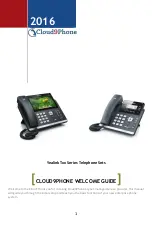
Copyright 2010-2015 Obihai Technology, Inc.
23
Remote Provisioning
This is the process by which the OBi downloads a configuration file from a server, which may be located in the cloud or
in the same enterprise. The configuration file may contain all the necessary parameter values for the phone to function
normally, it may also tell the device to download an additional configuration file from a different URL, or to download a
different firmware to replace the current one, and so on. The configuration file format and parameter naming
conventions are proprietary to Obihai but are common across all Obihai products.
There are currently two configuration file formats supported: A full XML format with the XML tags in full text and a
short XML format with the XML tags substituted with a single letter abbreviation. The XML structure and parameter
naming convention closely follows TR-104. For a full description of the configuration file and parameter names, please
refer to the
OBi Device Provisioning Guide
.
Similar to the way parameters are grouped under different device configuration web pages, parameters are grouped
into a number of configuration objects for remote provisioning. In fact you will find a near one-to-one correspondence
between these objects and their location within the configuration web pages. To illustrate this, consider the web page
SP1 Service, the SIP Credentials section:
The corresponding configuration object in a phone configuration XML file is:
VoiceService.1.VoiceProfile.1.Line.1.SIP.
as shown below:
<
Object
>
<
Name
>
VoiceService.1.VoiceProfile.1.Line.1.SIP.
</
Name
>
<
ParameterValueStruct
>
<
Name
>
AuthUserName
</
Name
>
<
Value
>
</
Value
>
</
ParameterValueStruct
>
<
ParameterValueStruct
>
<
Name
>
AuthPassword
</
Name
>
<
Value
>
zYz123#$12
</
Value
>
</
ParameterValueStruct
>
<
ParameterValueStruct
>
<
Name
>
URI
</
Name
>
<
Value
X_UseDefault
=
"
Yes
"
/>
</
ParameterValueStruct
>
<
ParameterValueStruct
>
<
Name
>
X_MyExtension
</
Name
>
<
Value
>
16188
</
Value
>
















































